If you find this manual useful,
how about a donation of
$3 to:
M. Butkus, 29 Lake Ave.,
High Bridge, NJ 08829-1701
and send your e-mail
address
so I can thank you.
Most other places would charge
you $7.50 for
a electronic copy
or $18.00 for a hard to read Xerox copy.
This will help me to continue to host this site,
buy new manuals, and pay their shipping costs.
It'll make you feel better, won't it ?
If you use Pay Pal, use the link below.
Use the above address for a check, M.O. or cash.
Venmo @mike-butkus-camera Ph. 2083
Back to main camera manual page
<<< IF YOU WOULD LIKE THIS OR ANY PDF FILE
PRINTED, BOUND AND MAILED TO YOU,
SEE THIS OUTSIDE COMPANY'S OFFER >>>
Problems
opening PDF files or printing problems
- click here
Click here for PDF version of this
Chinon Bellami manual - better printing

NOMENCLATURE (BELLAMI)
(Please refer to Figures A, B. and C in accompanying illustrated Guide)
1. Film Rewind Knob/Back Cover Opener
2. Viewfinder
3. Cds Automatic Electric Eye
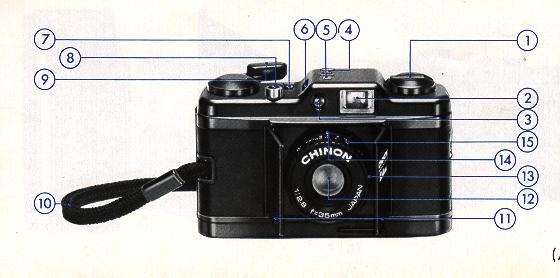
4. Battery Check (LED)
5. ASA/DIN Film Speed Window
6. ASA/DIN Film Speed Dial
7. Frame Counter
8. Shutter Release Button
9. Film Advance Lever/Dust Cover Control (Open/Close)
10. Wrist Strap
11. Dust Cover
12. Chinon Lens
13. Focus Ring
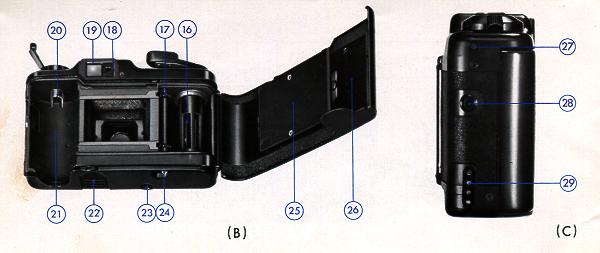
14. Focus Indicator
15. Distance Scale
16. Take-up Spool
17. Sprocket
18. Slow Shutter Speed Warning/Flash Ready Light (LED)
19. Viewfinder Eyepiece
20. Rewind Spindle
21. Film Chamber
22. Battery Compartment Cover
23. Tripod Socket
24. Film Rewind Button
25. Film Pressure Plate
26. Back Cover
27. Flash Sensor Pin Socket
28. Flash Retaining Socket
29. Electrical Contacts for S-120 Flash
NOMENCLATURE (S-120 FLASH)
(Please refer to Figures D and E in accompanying Illustrated Guide)
30. Flash Ready Light
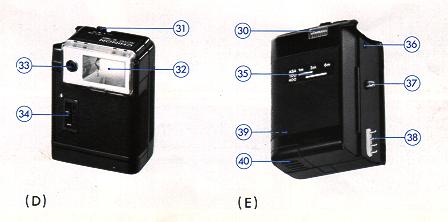
31. Flash Mode Selector
32. Flash Window
33. Auto Flash Sensor
34. Flash Locking Dial
35. Flash Distance Guide
36. Flash Sensor Pin
37. Flash Retaining Screw
38. Electrical Contacts for Bellami
39. Battery Compartment
40. Battery Compartment Cover
SPECIFICATIONS OF CHINON BELLAMI CAMERA
Type: 35 mm EE Compact Camera with Retractable Lens System
Negative Size: 24 X 36 mm
Film: 35 mm Film Lens: F/2.8 35 mm, 4-elements in 3-groups
Viewfinder: Bright Frame, Viewfinder Magnification (0.5X)
Shutter: SEIKO Program EE Shutter, Shutter Speed from 1/8 to 1/1000
sec.
Exposure Meter: Cds EE Exposure System, EV6 - 17(ASA 100), ASA25-400
(DIN 15 - 27)
Minimum Focusing Distance: 1 m (3.3 ft.)
Film Wind: Single stroke
Film Counter: Automatically indicates number of exposures and resets
to "0" position when the camera back is opened.
Film Rewind: Folding Crank type
Flash: Chinon Dedicated Auto Flash provision, built-in flash ready
lamp (red LED)
Synchronization: "X" Flash Sync.
Dust Cover: Dust cover can be opened and closed easily by the film
advance lever. Meter switch is activated while the
dust cover is fully opened.
Battery Check: Built-in Green LED
Slow Shutter Speed Warning: Built-in Red LED
Accessory: Chinon Dedicated Auto Flash S-120
Power Source: Two 1.5V Alkaline batteries (LR 44, A 76) or Two 1.5V
Silver Oxide batteries (SR44, G 13, S76)
Dimensions: 105 (L) X 63 (H) X 33 (W) mm (4.13" X 2.48" X 1.29")-When
dust cover is closed
Weight: 220 grams (8.8 oz.)
SPECIFICATIONS OF CHINON AUTO S-120
Type: Automatic Electronic Flash dedicated for Chinon Bellami Camera
Guide Number: 12 (ASA 100, Meters), or 39 (ASA 100,Feet)
Applicable ASA Film Speeds: ASA 100 and 400. Film speed is
automatically set when the ASA film speed dial is set to these positions.
Flash Mode Selector: Switch for Auto Flash Daylight Sync. and Off
positions.
F Stop for Auto Flash: F/4 (ASA 100, 400). F stop is automatically set
to F/4 by the auto flash.
Auto Operation: 1-3 m (3.28 - 9.84 ft.)—ASA 100 1.7 - 6 m (5.58-19.68
ft.)—ASA 400
Illumination Angle: Picture area of 35 mm focal length lens
Number of Flashes: Approximately 120 with AA size Alkaline battery
Recycling Time: Approximately 10 seconds with AA size Alkaline battery
Power Source: One 1.5V AA size Alkaline battery
Dimension: 60 (H) X 44 (W) X 33 (D) mm (2.36" X 1.73" X 1.30")
Weight: 60 grams (2.1 oz.) without battery
.
INTRODUCTION
Welcome to the world of Chinon Photography!! Your Chinon Bellami is one of
the most advanced ultra compact 35 mm cameras with attractive features available
today. Some outstanding features include, mini size, lightweight, retractable
lens system, electromagnetic programmed EE shutter, Cds automatic exposure
system, a sharp 35 mm F/2.8 all glass 4 element lens, dedicated auto flash
provision and many more.
The Chinon Bellami employs the latest state of-the-art electronics which will ensure carefree operation every time.
In order to take full advantage of the features of your Chinon Bellami, please read the instruction manuals carefully so as to totally familiarize
yourself with the camera before actually starting to take pictures.
We thank you for choosing Chinon quality products and we wish you years of satisfaction and enjoyment.
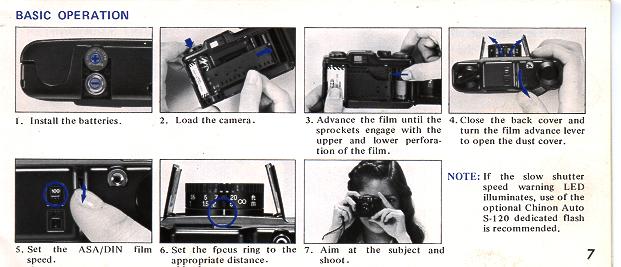
RETRACTABLE LENS SYSTEM (Figures are at
end of page)
The lens of your Bellami camera is retractable. In order to extend the lens to take a picture, turn the film advance lever completely until it stops. The
dust cover will open and the lens will be set to the picture taking position (Fig. I ). To close the dust cover and return the lens to the protected
position, push the film advance lever to the original position (Fig. 2).
Opening the dust cover fully switches the camera power ON and all camera functions are operational. Closing the dust cover switches the power OFF and all
camera functions are deactivated.
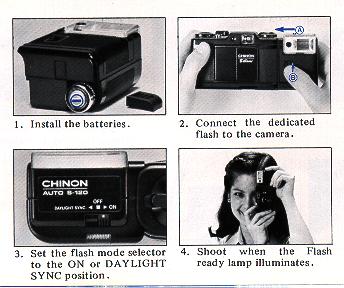
NOTE: *Make sure that the dust cover is fully opened when you take a picture.
**When your camera is not used or carried with you, close the dust cover to protect the lens from dust or foreign objects, and to avoid accidental shutter release.
INSTALLING THE BATTERIES
1. Slide the battery compartment cover along the arrow mark designation with your finger to open the battery compartment cover (Fig. 3).
2. Place two 1.5V alkaline batteries or silver oxide batteries (Fig. 4).
3. Replace the battery compartment cover until a click sound can be heard (Fig. 5).
NOTE: *Clean the batteries with a dry cloth or paper tissue before inserting.
** Be sure that batteries are inserted correctly, i.e. check polarity.
*** The shutter will operate only when batteries are correctly inserted and
not exhausted.
*** Use the following 1.5V alkaline batteries: LR44, A-76 or equivalent.
Use the following silver oxide batteries: G-13, SR44, EXP-76, MS-76 or equivalent.
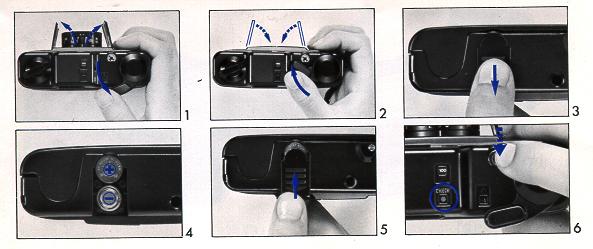
BATTERY TESTING
Test the batteries when:
-- new batteries are installed
-- the camera has not been used for a long period of time
-- the camera is being used continuously for many hours
To test the batteries, press the shutter release button slightly while the dust cover is fully opened and the lens is in the ready position. If the batteries
are in good condition, the green LED located at the top of the camera will illuminate (Fig. 6).
If the LED fails to illuminate, the batteries are too weak and need to be replaced, or they are incorrectly inserted.
NOTE: The batteries will last about one year and must be replaced with two 1.5V alkaline or silver oxide batteries.
FILM LOADING
Your Chinon Bellami camera can be used with the most popular 35 mm films available today.
1. Pull up the film rewind knob until the camera back pops open (Fig. 7).
2. Then, insert a film cartridge into the film chamber with the protruding end facing the bottom of the camera (Fig. 8).
3. Push in the film rewind knob and slightly turn the knob in either direction until it catches the film cartridge spool.
4. Insert the trimmed end of the film into a slot of the multi-slotted take-up spool.
5. Rotate the take up spool with your thumb to advance the film until the sprockets engage with the upper and lower perforations of the film (Fig. 9).
6. Close the camera back firmly until it locks with a click (Fig. 10).
7. Turn the film rewind knob gently until the film slack is taken up and the rewind knob stops turning freely. Do not force or further rewind the film.
8. Advance the film and release the shutter three times (Fig. 11 ). The rewind knob should rotate counterclockwise when the film is advanced, and the "
I " marking should appear in the frame counter window. (Fig. 12).
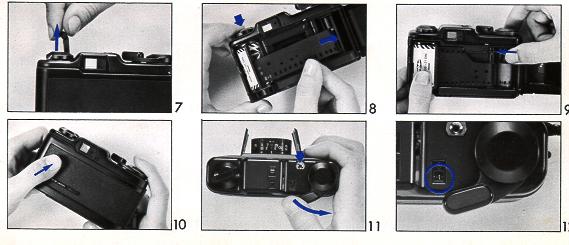
ASA/DIN SETTING
Make sure the correct ASA/DIN film speed is set in the camera to correspond with the ASA/ DIN film speed indicated on the film box. Turn the ASA/DIN film
speed dial to select the appropriate ASA/DIN Speed in the ASA/DIN Speed window on the top of the camera (Fig.13)
* In the event you are using a film with an ASA/DIN speed not indexed in the film speed window, you should select the
appropriate ASA setting according to the following table:
* For proper exposure, the ASA/DIN dial must be set on an indicated ASA setting (25, 50, 100, 200 or 400) and not in between.
|
CAMERAS
|
25 |
50 |
100 |
200 |
400 |
| ASA |
20 25 32 |
40 50 64 |
80 100 125 |
160 200 250 |
320 400 500 |
| DIN |
14 15 16 |
17 18 19 |
20 21 22 |
23 24 25 |
26 27 28 |
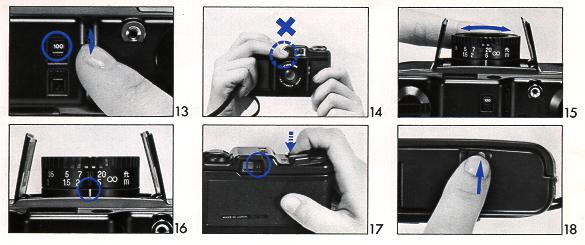
AUTOMATIC EXPOSURE SYSTEM
Your Chinon Bellami is equipped with a Cds automatic exposure system which will control the exposure level automatically for any picture taking situation.
NOTE: Do not obstruct the Cds Automatic Electric Eye so as to always ensure correct exposure
(Fig. 14).
FOCUSING At first, estimate or measure the camera-to subject distance and rotate the focusing ring to the appropriate
distance (Fig. 15). The following table shows the camera-to-subject distance that the focusing ring represents:
|
METER
|
|
1.5
|
|
|
|
(infinity)
|
| FEET
|
3.5
|
|
|
10
|
20
|
(infinity)
|
* Safety Focusing: Under sufficient lighting conditions,
i.e., when you are taking pictures outdoors, the need for focusing is
virtually eliminated. All you have to do is set the focusing ring to the
"3M" green marking
* Depth of Field:
| METER
|
|
1.5
|
|
|
(infinity)
|
| FEET
|
3.5
|
10
|
20
|
(infinity)
|
| Sunny day, seaside
|
*
|
* |
*
|
* |
| Sunny day, scenery or portrait
|
* |
*
|
*
|
|
SHUTTER RELEASE
Your Bellami is equipped with a SEIKO programmed electronic shutter which
automatically determines the best combinations of the shutter speed and aperture
value for a given lighting situation. First be sure to hold the camera steady
and press the shutter release button halfway. If the slow shutter speed warning
LED located on the viewfinder frame illuminates (Fig. 17), hold the camera as
steadily as possible to prevent camera movement and blurred picture. Keep the
shutter release button depressed until the warning LED turns off. Use of a
tripod or flash is highly recommended. If the warning LED does not illuminate,
press the shutter release button completely since the shutter speed is faster
than 1/60 sec.
NOTE: Be sure not to block the lens, electric eye, flash window or
auto-flash sensor when releasing the shutter.
UNLOADING EXPOSED FILM
When the film in the camera is fully exposed, the film advance lever will
stop. Do not attempt to force the lever any further. Rewind the film and replace
it with a new film.
1. Close the dust cover and push in the rewind button at the bottom of the
camera (Fig. 18).
2. Unfold the rewind crank of the rewind knob and turn the rewind crank
clockwise (Fig. 19). You will feel friction as the film is rewound. Suddenly,
when the film is rewound completely, the friction decreases and the rewind crank
will turn with ease.
3. Pull up the rewind knob to open the camera back (Fig. 20). When the camera
back is opened, the frame counter will automatically reset to the "S" position.
The rewind button on the bottom of the camera will pop out upon the next
advancement of the film advance lever.
NOTE: Do not take the film out of your camera in bright sunlight. Your
exposed film should be processed without delay.
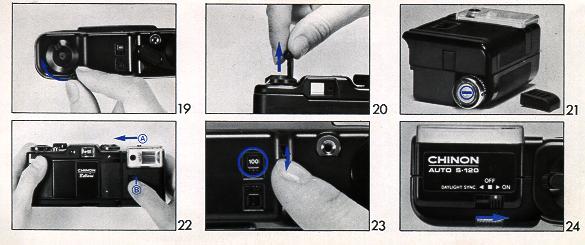 CHINON DEDICATED FLASH SYSTEM
CHINON DEDICATED FLASH SYSTEM
A specially designed and developed automatic flash unit Chinon S-120 is
available for your Chinon Bellami camera as an optional accessory. This highly
advanced dedicated flash system permits carefree flash photography.
1. Install one AA size alkaline battery according to the polarity indicated
in the battery compartment (Fig. 21).
2. Connect the flash unit to the camera (Fig. 22-A). Insert the retaining
screw into the flash retaining socket on the side of the camera. Turn the flash
locking dial until the unit is secured. (Fig. 22-B).
3. Set the ASA/DIN film speed in the camera to ASA 100 or 400 (Fig. 23). The
flash unit will be automatically set by the camera.
Set the flash mode selector to the "ON" position (Fig. 24). If used in daylight,
set the flash to the "DAYLIGHT SYNC" position.Make sure that the flash ready
light on the flash unit is illuminated (Fig. 25). The flash ready light on the
viewfinder frame will also flash when the shutter release button is partially
depressed signaling the flash is fully recycled and ready to take a picture
(Fig. 26). The flash ready light usually illuminates a few seconds after the
flash is switched to the "ON" position and when the battery is fresh.
Adjust the focus to the desired distance and depress the shutter release
button (Fig. 27). 7. Return the flash mode selector to the "OFF" position (Fig.
28).
NOTE: Be sure that your finger does not cover the flash or light meters.
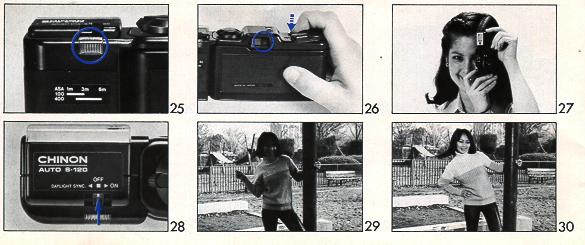
A. Automatic ASA/DIN Setting
When the ASA/DIN film speed is set to ASA 100 (DIN 21) or ASA 400 (DIN 27),
the flash unit is automatically synchronized. If the ASA/DIN film speed of the
film to be used, is close to ASA 100 or ASA 400, use the nearest setting,
referring to the following table:
|
SETTING
|
100
|
400
|
|
ASA
|
80 100 125
|
320 400 500
|
|
DIN
|
20 21 22
|
26 27 28
|
B. Adjustable Flash Range ("ON" position)
The flash system is compatible with major ASA/DIN film speeds available. The
flash System will automatically compensate to the indexed film speed. If you
want to take a picture of the subject which is more than 3M (10 ft.) from your
camera, use a high speed ASA/DIN film. The following table shows the effective
range of the flash system.
| ASA
|
100
|
400
|
| METER
|
1 - 3
|
1.7 - 6
|
| Feet
|
3.3 - 10
|
5.6 - 20
|
C. Daylight Flash Photography
("DAYLIGHT SYNC" Position)
If the main subject has less light falling on it than the surrounding area
and background, such as backlight situations or when the subject is beside a
sunny window in an interior, under exposure of the main subject will result. In
such situations, it is recommended to use the auto flash for the photograph even
in daylight situations (Fig. 29 & 30). For best results, with outdoor "Fill-in
flash", the flash unit should be employed within the following range:
1M - 3M (3.3 - 10 ft.) . . . Outdoors on sunny days (ASA 100)
1M - 5M (3.3 - 16 ft.) . Outdoors on cloudy days or indoors besides a sunny
window (ASA 100)
D. Flash Ready Light
The flash ready light of the flash unit will illuminate when it is ready to
fire. Plus, the flash ready light (LED) on the viewfinder frame of the camera
will also flash when the shutter release button is partially depressed signaling
the flash is ready.
Note: The flash ready light on the camera will not flash signaling when the flash is set to
the "DAYLIGHT SYNC" position and it is under exposure.
CARE OF THE CAMERA
You Chinon Bellami camera is a precision instrument. When used with care,
it will provide you years of trouble-free service. Protect your camera from
dirt, rain, dampness or excessive heat. Avoid touching the lens. To clean the
lens wipe it gently with a soft lintless cloth or tissue. Do not use eyeglass
tissue as it may damage the lens coating. If service should be necessary,
contact your Chinon dealer or an authorized Chinon Service station.
* When you are finished taking photographs, it is recommended to
close the dust cover of your camera completely so as to prevent battery
drain.










